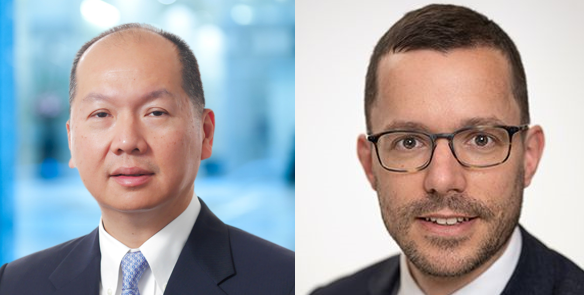Breadcrumbs
Drs. Terrence Yau and Christoph Haller secure $24 million New Frontiers in Research Fund as co-Principal Investigators in “Enabling novel cardiac therapies with pluripotent stem cells” program

Dear Colleagues,
Please join me in congratulating Drs. Terrence Yau and Christoph Haller, who are co-Principal Investigators on a team grant for $24 million as part of Canada’s New Frontiers in Research Fund (NFRF), under the Transformation category. The grant is for their proposed program for “Enabling novel cardiac therapies with pluripotent stem cells”. The team comprises world leaders in a range of fields necessary to advance the project, led by Dr. Michael Laflamme (Professor, Laboratory Medicine and Pathobiology).
This project is one of only 6 funded Canada-wide, all of which are Canadian-led, large-scale interdisciplinary research projects addressing major global challenges.
Their project addresses cardiovascular disease, the leading cause of death worldwide, accounting for nearly one-third of all global deaths. Each year approximately 70,000 Canadians suffer a heart attack (or myocardial infarction—MI), accounting for the majority of the approximately 50,000 new cases of heart failure diagnosed annually.
The proposed program rationale is that “The transplantation of some adult stem cells appears to mediate small improvements in contractile function, but there is consensus that these cells do not yield significant numbers of new cardiomyocytes and instead work through indirect mechanisms, such as immunomodulatory or pro-angiogenic signaling. However, CM deficiency underlies most causes of heart failure. The program proposes to develop and translate ground-breaking regenerative therapies for intractable forms of heart failure based on human pluripotent stem cell (hPSC)-derived cardiomyocytes and cardiac tissues.”
You can read about the grant’s significance in this article: Government of Canada invests in high-risk, high-reward interdisciplinary research to support world-leading innovation - Canada.ca. You can also view all the Transformation 2022 project listings here.
Your colleagues from the U of T Department of Surgery are very proud of your remarkable achievement, Dr. Yau and Dr. Haller. Your dedication to improving national and global surgical care is exemplary and inspiring. We are so excited to see the positive impact this grant will have on cardiac surgery and stem cell therapies in Canada and beyond.
Congratulations!
Sincerely,

Carol J. Swallow MD PhD FRCSC FACS
RS McLaughlin Professor and Chair
Department of Surgery, University of Toronto
More About the Project
Cardiovascular disease is the leading cause of death worldwide, accounting for nearly one-third of all global deaths. In Canada, the most rapidly rising form of cardiovascular disease is heart failure, a disorder in which the heart cannot pump blood to the body at a rate commensurate with its needs. Each year approximately 70,000 Canadians suffer a heart attack (also known as a myocardial infarction—MI), accounting for the majority of the approximately 50,000 new cases of heart failure diagnosed annually. The adult human heart has very limited regenerative capacity, so muscle lost to MI or other injury is replaced by non-contractile scar tissue, often initiating progressive heart failure.
Existing therapies for heart failure are largely aimed at easing symptoms or slowing disease progression rather than restoring lost contractile function, and the median survival for heart failure patients remains only 2.1 years. This situation and the very limited supply of donor hearts for transplantation has led to a worldwide quest to promote heart regeneration. The transplantation of some adult stem cells appears to mediate small improvements in contractile function, but there is consensus that these cells do not yield significant numbers of new cardiomyocytes (CMs) and instead work through indirect mechanisms, such as immunomodulatory or pro-angiogenic signaling. However, CM deficiency underlies most causes of heart failure.
Our New Frontiers program proposes to develop and translate ground-breaking regenerative therapies for intractable forms of heart failure based on human pluripotent stem cell (hPSC)-derived CMs and cardiac tissues. Past efforts to regenerate the heart have been hindered by grand challenges related to the immature phenotype of hPSC-CMs, cell manufacturing, and poor survival, integration, and function of the implanted cells.
To overcome these barriers, our multi-institutional, international team with expertise across six diverse disciplines has co-designed three translational research aims:
Aim 1. Create hPSC-derived cardiac microtissues (cMTs) for regenerating infarcted hearts. Key deliverables: optimized methods for large-scale manufacturing of all relevant cardiac cell types and cMTs; the first protocol for the differentiation of specialized Purkinje fibers (PFs) from hPSCs; pivotal preclinical safety and efficacy data with an injectable cell product for post-MI heart failure; and an early health technology assessment (HTA).
Aim 2. Create augmented human ventricular myocardium – “better than nature”. Key deliverables: the first proof-of-concept for “next generation” cardiac cell therapies engineered to have enhanced functional properties; an HTA for these technologies; and a new framework of ethical and social principles to guide this new paradigm in regenerative medicine.
Aim 3. Develop the first biological biventricular pump (bio-biVP) using hPSCs. Key deliverables: a prototype neonatal-scale 3D bioprinted human heart construct (in normal and, ultimately, augmented versions incorporating outputs from Aim 2); a complete data set describing bio-biVP functionality in vitro and in vivo; an HTA; and early planning of clinical trial design and bioethics.
Aim 1. Create hPSC-derived cardiac microtissues (cMTs) for regenerating infarcted hearts. In Y1-2, we will generate mature left and right ventricular CMs at scale, establish a protocol for guided differentiation of specialized cardiac Purkinje fibers from hPSCs, and engineer hPSC-derived microvessels. In Y2-3, we will determine the optimal combination of the various cardiac cell types for infarct regeneration and generate injectable hPSC-derived cardiac microtissues (hPSC-cMTs) for preclinical testing. Finally, to ensure innovation viability, we will conduct a heath technology assessment (HTA) for the regenerative therapies developed in Aims 1-3. Impact: This work will develop and validate a truly regenerative therapy based on hPSC-cMTs for patients with post-MI heart failure, which would be a landmark achievement for the field. These foundational studies will also unlock the possibility of even greater advances via the creation of enhanced cardiac tissues (Aim 2) and ultimately whole replacement organs (Aim 3).
Aim 2. Create augmented human ventricular myocardium – “better than nature”. We will integrate synthetic biology, gene editing, and regenerative medicine to create hPSC-derived cMTs engineered with enhancements such as arrhythmia resistance, ischemia tolerance, enhanced contractility, increased longevity and/or pathogen resistance. To ensure that the enhanced cardiac cell therapies that we will develop are safe, efficacious and ethical, we will establish a new framework of governing ethical and social principles (Y2-3) and use mathematical modeling to make predictions about the effects of specific augmentations (Y2-5). After creating and validating augmented hPSC-cMTs in vitro (Y2-4), we will advance the most promising cell products to preclinical testing (Y3-6). Impact: Technologies developed in this aim will substantially improve the safety and efficacy of hPSC-based cardiac cell therapy. Proof-of-concept for replacing damaged myocardium with tissue potentially better than what was lost would be a revolutionary advance in the field and a major step toward our envisioned “heart of the future”.
Aim 3. Develop the first biological biventricular pump (bio-biVP) using hPSCs. In work combining stem cell biology, cell manufacturing, mathematical modeling, and tissue engineering, we will use 3D bioprinting to create the world’s first bio-biVP heart construct comprised of the authentic human cell types (Y3-5). Our human bio-biVP will be comprehensively phenotyped and ultimately tested in preclinical transplantation experiments (Y5-6). Impact: The successful creation and validation of a bio-biVP would represent a ‘tour de force’ for tissue engineering and a tremendous advance toward the long-term goal of providing an alternative to organ transplantation for heart failure patients. Our bio-biVP technology would also have immediate application as a near-physiological human heart model suitable for investigating cardiac development, modeling of complex cardiac diseases, and drug discovery.
The proposed NFRF program will result in revolutionary new therapeutic options for heart failure and a paradigm shift in clinical care. Our interdisciplinary program will provide unique career development opportunities for ECRs and trainees. In the long term, our efforts to apply the tissue engineering and synthetic biology toolkits to hPSCs will inspire an entirely new form of regenerative medicine applicable to diseases even beyond the heart.
